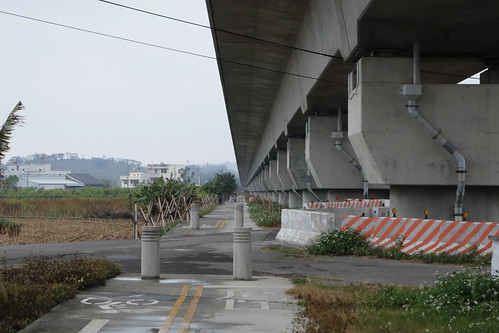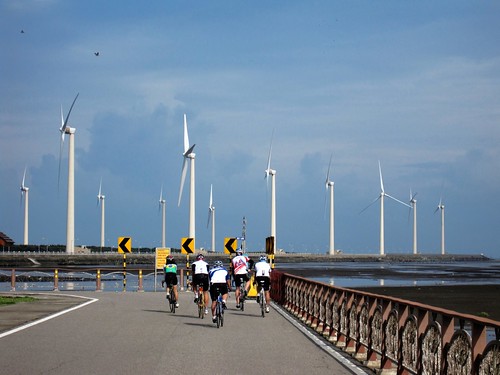
Another bike path to nowhere. This beautiful path has no destination. Photo courtesy of Michael Turton
So, from what they say, 2015 will be the year of the bike path. Taiwan's central government is planning to connect several existing bike systems together into a complete cycling transportation network by the end of the year.
The executive Yuan explains:
As for promoting cycling as a sport, Premier Jiang emphasized that ministries should build up a cycling atmosphere around the more popular routes and attract more foreign tourists for biking in Taiwan. Since this effort involves infrastructure construction, software management, promotion and marketing....and further
MOTC said it is planning to integrate bike paths with railways, buses, scenic spots, restaurants, accommodations and tours to provide a quality, safe and green cycling environment. Meanwhile, it will team up with the Sports Administration to assist local authorities to install bike path signs and mileage markers. It will also work with the MOI and MOE to include bike paths into land development and tourism plans, helping to create jobs, serve the physically active population and spur local industries.An old report from Taiwan Today:
Under the NT$1.2 billion (US$40.2 million) government-funded project, 60 in-place paths are to be linked. Comprising paths, provincial highways and rail connections, the network will enable cyclists to complete a round-island-tour of 1,000 kilometers in nine days.
“Since I took office in May 2008, Taiwan’s bikeways have grown from 720 kilometers to 4,017 kilometers, President Ma Ying-jeou said at a Ministry of Education-hosted meeting with the nation’s youth Aug. 31 in Taipei City. “I have instructed the Ministry of Transportation and Communications to prioritize mapping the network and promoting it abroad.”
I would and should be ecstatic over this. As a cyclist I should feel like pogoing with pom poms a blazing in support of a bold government initiative to promote and develop a greater cycling infrastructure. I should. I really should.
But I can't.
On its surface it looks great. Upon closer examination this looks like another publicly funded black box program that diverts valuable resources away from where they would be most beneficial and locks them up in a mysterious scheme that serves as resume padding for elected officials in the lead up to an election year. No maps or plans are available for public scrutiny. The plans are left to localities to implement and the number of people served is greatly reduced by only focusing on cycling tourism. The government even had the gall to blow a bunch of smoke in regard to "reducing traffic-related pollution while boosting Taiwan’s tourism appeal." The cynicism hurts to the point of laughter. Not only is it unclear which businesses would benefit, nor does the plan specify an exact route, but is typical Taiwan fashion, the plan also does not allocate any funds for regular maintenance or safety.
Well done!
The fact of the matter remains that focusing on weekend and leisure cyclists as well as niche tourism, takes NT$1.2 billion dollars and throws it into putting garlands on an ass.
This is a symptom that is rampant with Taiwan's cycling infrastructure.
The majority of Taiwan is impeccable for cycling. The gaps between cities host dozens of excellent routes a cyclist can choose from. There are lovely roads that parallel other lovely roads. To narrow them down would be a disservice to the traveller. The problem is not in the gaps between cities where it appears much of this fund will be spent.
The central government needs to quit throwing money into the black holes of local construction contractors and their political patrons.
The greatest need for NT$1.2 billion in cycling infrastructure is in the cities once a cyclist has covered the gaps. Once a cyclist navigates through the countryside and arrives in Hsinchu, Chiayi, Taichung or Changhua... what then? There is nothing. The cities are not designed to accommodate the bicycle as a regular part of the transportation system and there have been no serious moves to actually move toward the bicycle's integration.
Various cities have gone as far as public bicycle rental schemes, which are actually quite handsome and conspicuous, but the bicycles really have nowhere to safely go. I often see these orange, slow moving bikes weaving in and out of traffic and uneasily along sidewalks. There will be no reduction of emissions when inviting foreign visitors to ride their bikes around Taiwan.
We hear of fancy bike trails like the congested Hou-Feng and Sun Moon Lake trails, but these are completely purposed for occasional entertainment. They benefit a few tourism interests and rental stations, but mean nothing to the majority of Taiwanese.
Taiwan can do without overdeveloping the rural cycling atmosphere... but Taiwan can not continue to ignore the need for a serious and public approach to integrating the bicycle into the daily lives of its urban majority.
I hope the new local heads can look beyond the cash rewards of a vague government program, and decide to use the cash in areas that may actually impact the lives of their constituents.


